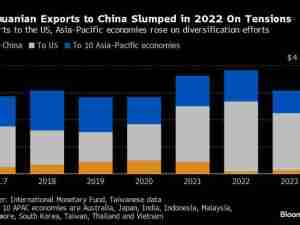Australia’s rock lobsters—a long-prized delicacy among Chinese consumers—may be finding their way onto mainland menus through a backdoor that circumvents a worsening diplomatic and trading dispute between the two nations.
Since direct shipments to China virtually ground to a halt last November, Hong Kong has become the world’s largest importer of Australian lobsters, with monthly trade growing more than 2,000% from October to April. While lower prices will have spurred some increased demand from Hong Kong consumers, experts say the dramatic spike is more likely due to a gray trade as the tasty crustaceans are sent across the border to the mainland.
“It’s highly unlikely that locked-down Hong Kong citizens are suddenly buying, cooking and eating 20 times more lobster in their homes over the last six months,” said Deborah Elms, the Singapore-based executive director of the Asian Trade Centre. “Lobster is a high-value product. As with any high-value product, the incentives to skirt the rules are also high.”
Customs clearance delays and increased inspections for lobsters, which are typically flown in on ice to be consumed within 72 hours or put into holding tanks, saw plane loads of exports perishing on the airport tarmac late last year. Australian officials, who investigated complaints of heavy metal traces in two shipments and reported back to Chinese authorities in December, are still awaiting a response.
Lobsters are the latest in a string of Australian exports to be caught up in the widening spat between Australia and China, after Prime Minister Scott Morrison’s government led calls for an independent inquiry into the origins of the coronavirus.
China accounted for 93% of Australian lobster exports worth A$544 million ($412 million) in 2019-20, according to official government statistics compiled by the Canberra-based Fisheries Research and Development Corporation.
Lobster, which translates to dragon shrimp in Chinese, is viewed as a symbol of prosperity due to its auspicious name and vibrant red hue. Often steamed and presented with its shell intact at celebratory banquets, Australian rock lobsters are famous for their fine yet firm texture, salty tang and sweet aftertaste, retailing at a price two to three times that of Maine lobsters before China’s unofficial ban.
The trade has slumped by 99% this year to April from the same period last year.
Meanwhile, the value of Australian lobster exports to Hong Kong in April was A$25 million—the highest monthly total since February 2013, FRDC data show. The total for the first four months of the year was A$78.1 million, more than triple the value for the whole of 2020.
It’s unlikely they have all stayed within the territory.
China’s fish and crustaceans imports from Hong Kong jumped from $500,247 in September last year to $10.6 million in April, Chinese customs data show.
On Baidu’s wholesaling platform, multiple suppliers continue to offer Australian lobsters. JD.com, one of China’s leading e-commerce sites, currently displays live Australian lobsters selling at around 1,500 yuan ($232) each, some with same-day delivery for Guangdong.
Backdoor shipments from other economies are often a means of sidestepping restrictions, according to the Asian Trade Centre’s Elms.
Before the China-Australia Free Trade Agreement entered into force in late 2015, commodities were often shuttled by Chinese importers through Southeast Asian nations to avoid tariffs, according to the Australian Broadcasting Corp., which reported on the gray trade through Hong Kong earlier this month.
Andrew Hudson, a partner at Melbourne-based Rigby Cooke Lawyers who specializes in customs and trade, said the Australian government had ensured air links to Hong Kong remained open during the pandemic through its International Freight Assistance Mechanism. He also cited the possibility of gray trading, on top of increased demand from Hong Kong consumers due to lower prices, for the spike in lobster exports.
Australia’s Department of Foreign Affairs and Trade said it was supporting the lobster industry “to grow trade to existing markets and identify new opportunities.”
“Australia respects the right of importing nations to undertake science and risk-based safety and quarantine checks, but any arrangements shouldn’t unnecessarily impede our exporters’ ability to trade in time-sensitive, high-value products,” the department said.
China’s customs administration wasn’t immediately available for comment.






